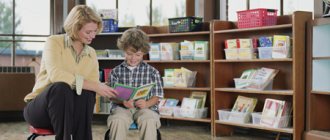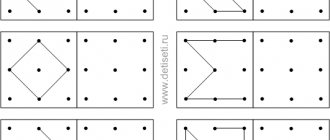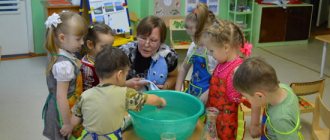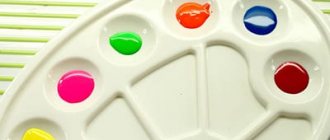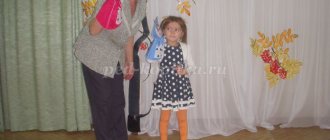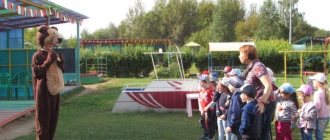Preparatory group. Senior preschool age. Children 6-7 years old
Abstract of educational activities on cognitive and research activities in a preparatory school group on the topic “Magnet and its properties” State budgetary preschool educational institution “Kindergarten No. 67”
compensatory type
Abstract of educational activities on cognitive and research activities in the preparatory school group. Topic: “Magnet and its properties”
.
Prepared by: Teacher of the State Budgetary Educational Institution “Kindergarten No. 67”
...
Abstract of the OOD on the development of cognitive and research activities “Miracle Salt” in the preparatory group Municipal budgetary preschool educational institution Kindergarten No. 33 “Rodnichok”
urban district of the city of Oktyabrsky of the Republic of Bashkortostan
Abstract of organized educational activities for the development of educational and research activities on the topic : “Miracle salt”
...
Cognitive and research activities of preschool children in the context of the introduction of the Federal State Educational Standard for Education
It is known that preschool childhood is a unique time for the development of a child’s abilities. One of the most important abilities is the ability to cognition. The development of cognitive activity has been considered in various works by teachers and psychologists. Y. A. Komensky, K. D. Ushinsky, D. Locke, Jean-Jacques Rousseau defined cognitive activity as the natural desire of preschool children to learn. A.K. Markova, V.P. Lozovaya, Zh.N Telnova, G.I. Shchukina and others studied the characteristics of cognitive activity and ways of activating it in preschool children.
The basic principles of preschool education in accordance with the Federal State Educational Standard for Preschool Education are the formation of cognitive interests and cognitive actions of the child in various types of activities. In addition, the standard is aimed at developing the intellectual qualities of preschoolers. According to it, the program should ensure the development of the personality of preschool children in various types of activities.
Federal State Educational Standards for Advanced Education pays special attention to cognitive and research activities (studying objects of the surrounding world and experimenting with them). Typical activities for the implementation of this area of work are:
– organization of solving cognitive problems;
– the use of experimentation in working with children;
– use of design.
The cognitive and research activities of a preschooler are based on curiosity, the desire for discovery, and the thirst for knowledge. Experimental activities in preschool educational institutions make it possible to satisfy these needs and thereby advance the development of the preschooler forward, develop his personal, physical and intellectual qualities.
In accordance with the requirements of the Federal State Educational Standard, kindergarten teachers are recommended to organize daily situations that provoke the cognitive activity of pupils. One of the forms of such influence is experimental research activities in preschool educational institutions.
Experimental research activities in kindergarten are effective activities aimed at developing the cognitive activity of preschoolers.
The content of the research involves the formation of the following ideas.
- About the world of animals and plants: how animals live in winter and summer; vegetables, fruits, etc.; conditions necessary for their growth and development (light, moisture, heat).
- About materials: clay, paper, fabric, wood, metal, plastic.
- About a person: my assistants are eyes, nose, ears, mouth.
- About natural phenomena: seasons, weather phenomena, objects of living and inanimate nature - water, ice, snow, etc.
- About the objective world: dishes, furniture, toys, shoes, transport.
- About geometric standards : circle, rectangle, prism, rhombus.
In the process of experimentation, the child’s memory is enriched, his thought processes are activated, as the need constantly arises to perform operations of analysis and synthesis, comparison, classification and generalization. The need to give an account of what is seen, to form discovered patterns and conclusions stimulates the development of speech. The consequence is not only the child’s familiarization with new facts, but also the accumulation of a fund of mental techniques and operations that are considered as mental skills.
At what age is it supposed to start experimenting in kindergarten?
From the second early age group (2–3 years), children begin to take part in joint experimental activities with the teacher. For now, they represent the simplest studies that help kids examine objects, noting their color, size or shape.
In the younger group (3–4 years), cognitive and research activities become more complicated. Together with the teacher, children learn to conduct experiments using sensory standards as an example. Thanks to experiments, they become clear about the previously hidden properties of the objects being studied.
Experimentation in the middle group (4–5 years old) is aimed at developing in children the ability to independently obtain information about a new object. All senses are actively used for experiments.
Using experimentation in the older group (5–6 years old), it is necessary to encourage children to independently carry out experimental actions and identify the hidden properties of phenomena and objects.
In the school preparatory group (6-7 years old), cognitive and research activities are improved. Not only independent work is encouraged, but also the choice of the optimal way to carry it out.
Preschoolers in the group should have free access to a special area - experimentation corner , in which the following are located:
- experiment kits with picture instructions;
- toys for research - balls, cubes, small objects made of different materials;
- various natural materials - sand, water, clay, shell, wool;
- measuring instruments - scales, measuring containers, hourglasses, rulers;
- tools - pipettes, spatulas, measuring spoons, toothpicks, transparent and colored glasses;
- another rich object environment - a mirror, a magnifying glass, salt, magnets;
- writing utensils for recording results.
In the experimental activity corner the following should be highlighted:
- senior preschool age;
- didactic component;
- equipment component;
- stimulating component;
— diagrams, tables, models with algorithms for performing experiments;
— a series of paintings depicting natural communities;
— educational books, atlases;
— thematic albums;
- collections;
— mini-museum (themes vary, for example, “There are different watches:”, “Stone products”;
— materials are divided into sections: “Sand, clay, water”, “Sound”, “Magnets”, “Paper”, “Light”, “Glass”, “Rubber”;
— natural material: stones, shells, saw cuts and leaves of trees, moss, seeds, different types of soil, etc.;
- recycled material: wire, pieces of leather, fur, fabric, plastic, wood, cork, etc.;
— technical materials: nuts, paper clips, bolts, nails, cogs, screws, construction parts, etc.;
— different types of paper: plain, cardboard, sandpaper, copy paper, etc.;
— dyes: food and non-food (gouache, watercolors, etc.);
— medical materials: pipettes with rounded ends, flasks, wooden sticks, measuring spoons, rubber bulbs, syringes without needles;
- other materials: mirrors, balloons, butter, flour, salt, sugar, colored and transparent glass, candles, etc.;
- sieve, funnels;
- halves of soap dishes, ice trays;
— parting assistants: magnifying glass, hourglass, microscopes, magnifying glasses;
- oilcloth aprons, sleeves, rubber gloves, rags;
— mini-stand “What I want to know about tomorrow”;
— personal notebooks for children to record the results of experiments;
— hint cards (permitting and prohibiting signs) “What is possible, what is not”;
- characters endowed with certain traits (“Pochemuchka”) on whose behalf a problematic situation is modeled.
In senior preschool, conducting experiments should become the norm; they should be considered not as entertainment, but as a way to familiarize children with the world around them and the most effective way to develop thought processes. Experiments and experiences make it possible to combine all types of activities and all aspects of education, develop observation and inquisitiveness of the mind, develop the desire to understand the world, all cognitive abilities, the ability to invent, use non-standard solutions in difficult situations, and create a creative personality.
Some important tips:
1. It is better to conduct experiments in the morning, when the child is full of strength and energy.
2. It is important for us not only to teach, but also to interest the child, to make him want to gain knowledge and do new experiments himself.
3. Explain to your child that you cannot taste unknown substances, no matter how beautiful and appetizing they look.
4. Don’t just show your child an interesting experience, but also explain in a language he understands why this happens.
5. Do not ignore your child’s questions - look for answers to them in books, reference books, and the Internet.
6. Where there is no danger, give the child more independence.
7. Invite your child to show his favorite experiments to his friends.
8. And most importantly: rejoice in your child’s successes, praise him and encourage his desire to learn. Only positive emotions can instill a love for new knowledge.
I offer some of the most interesting experiences and experiments that can be very interesting for children!
1. "Vanishing Chalk"
For a spectacular experience, we will need a small piece of chalk. Dip chalk into a glass of vinegar and see what happens. The chalk in the glass will begin to hiss, bubble, decrease in size and soon disappear completely.
Chalk is limestone; when it comes into contact with acetic acid, it turns into other substances, one of which is carbon dioxide, which is rapidly released in the form of bubbles.
2. “Magic Magnet”
1. Take a glass of water.
2. Place a wooden cube and paper clips in it.
3. Place a magnet against the wall of the glass: the magnet attracts only metal objects, even through glass and water.
3. “Tricks with magnets”
Task: identify objects that interact with a magnet.
Materials: magnets, a goose cut out of foam plastic with a metal rod inserted into its beak; a bowl of water, a jar of jam, a jar of mustard; a wooden stick, on one end of which a magnet is attached and covered with cotton wool on top, and on the other - only cotton wool at the end; animal figurines on cardboard stands; a shoe box with one side cut off; paper clips; a magnet attached with tape to a pencil; a glass of water, small metal rods or a needle.
The magician shows the children pictures of animals and asks: “Can my animals move on their own?” (No.) The magician replaces these animals with pictures with paper clips attached to their bottom edges. Places the figures on the box and moves the magnet inside the box. Why did the animals start moving? Children look at the figures and see that there are paper clips attached to the stands. Children try to control animals. A magician “accidentally” drops a needle into a glass of water. How to get it without getting your hands wet? (Bring the magnet to the glass.) Children use a magnet to independently remove various objects from the water.
Drawing with magnets
Materials for the experiment: 2 disposable plates, paints of different colors, magnetic balls, magnets.
Children are asked to pour a little paint into a plate and move the balls with a magnet under the plate.
4. Making soap bubbles . Objective: to introduce children to the method of making soap bubbles, to the properties of liquid soap: it can stretch and form a film.
Materials: liquid soap, pieces of soap, a loop with a wire handle, cups, water, spoons, trays.
5. Mysterious pictures Task: show children that surrounding objects change color if you look at them through colored glasses.
Materials: colored glasses, worksheets, colored pencils. Children sketch “mysterious pictures” on a worksheet.
6. Magic glass . Objectives: introduce children to observation instruments - microscope, magnifying glass, telescope, telescope, binoculars; explain why a person needs them.
Materials: magnifying glasses, microscopes, various small objects, small seeds of fruits, vegetables, leaves of trees, plants, tree bark; binoculars, pictures of a spyglass, telescope.
7. Experiments with water and salt
Freeze the water, slightly tinted with paint, and inside there are figurines of sea creatures. Purpose: to defrost and help the inhabitants free themselves from ice. Sprinkle salt and the ice melts.
8. Experiments with sand. Why is an hourglass called an hourglass?
Goal: to identify the properties of sand and clay.
Materials: containers with dry sand and clay. Transparent cups; planks; magnifying glass; sieve; hourglass.
Conducting the experiment:
- Take cups, fill one cup with clay, the other with sand.
— Look at clay and sand through a magnifying glass, compare how they differ? (Sand consists of small grains of sand, clay consists of lumps.)
- Take sand in your hands and rub it. Take the clay and grind it. Let's explain what's happening. (Sand pours out of hand, clay kneads.)
- Pour sand on one side of the board, clay on the other side of the board. Compare clay and sand slides. (A hill made of sand is smooth, a hill made of clay is uneven.) Why (Grains of sand are smooth and hard; lumps of clay are uneven and soft.)
- Take sand, clay and sift through a sieve one by one. Compare how grains of sand and clay lumps pass through a sieve. (Grains of sand pass easily and quickly, lumps of clay pass poorly and slowly.)
To summarize:
The main property of sand is flowability.
The main property of clay is friability.
Why? Sand consists of small grains of sand. They are hard, round, and do not stick to each other. The sand is pouring down. Clay consists of clay particles. They are soft, uneven, stick to each other. Clay doesn't flow
Conclusion: only sand is suitable for an hourglass, which is why this clock is called an hourglass
The project method also has wide opportunities for educational and research activities. This is a special technology of integrated learning, the meaning of which is the independent activity of children - research, cognitive, productive, during which the child learns about the world around him and translates new knowledge into real products.
Children love to share news, and so the problem arises: how to satisfy the desires of all children. The topic of the project should be proposed by the children themselves, based on their interests and needs. In junior and middle groups, you need to guide children to choose a project topic. Choosing a topic and children's interests begins with the “three questions model”:
- What do you know?
- What do you want to know?
- What should be done in order to find out?
The specific result of the work can be a drawing, an application, a written fairy tale, a performance, a concert, etc. During the implementation of the project, children develop independence, activity, responsibility, a sense of trust in each other, and most importantly, an interest in knowledge.
As part of educational and research activities, you can propose the projects “Water Sorceress”, “Products that are healthy and not so healthy”, “Scented soap”, “Vegetable garden on the windowsill”.
For example, during the project “Products that are healthy and not so good,” children explore the harmful effects of Coca-Cola and chips on the human body. After all, information obtained with one’s own hands is remembered by the child firmly and for a long time. Through entertaining experiments, children satisfy their natural curiosity and cognitive activity.
During the “Scented Soap” project, children, through experiments, confirm the hypothesis that the properties of soap directly depend on its composition. Children, together with their parents, will be able to make soap with different compositions at home.
I consider close interaction with parents and their involvement in joint activities to be an integral part of the work on developing children’s cognitive activity. For this purpose, consultations, holidays and entertainment, involving parents in the implementation of joint child-parent projects, etc. Parents and students should be involved in creating a cognitive and developmental environment in the group, replenishing them with the necessary materials.
In the parent’s corner, you can create a permanent section in “Let’s Experiment!”, in which educators offer parents various forms of conducting experiments and experiments together with their children. For parents, you can create a card index of elementary experiences and experiments that can be done at home. For example, “Colored Ice” (ice can be seen not only in winter, but also at any other time of the year if water is frozen in the refrigerator). The result of this work can be interesting stories from children and parents about how they together made soap and paper at home, grew crystals, dyed fabric, and made colored pieces of ice.
It is necessary to develop booklets and instructions for parents: “What not to do and what to do to maintain children’s interest in experimenting,” “How to help a little researcher,” “Entertaining experiments in the kitchen.”
Childhood years are the most important and how they will pass depends on the parents and on us, teachers. It is very important to reveal to parents in a timely manner the developmental aspects of each child and recommend appropriate parenting techniques. Analyzing all of the above, we can conclude that specially organized research activities allow our students to obtain information about the objects or phenomena being studied, and the teacher to make the learning process as effective as possible and more fully satisfy the natural curiosity of preschoolers, developing their cognitive activity.
In conclusion, I would like to quote the words of K. E. Timiryazev: “People who have learned... observations and experiments acquire the ability to pose questions themselves and receive factual answers to them at a higher mental and moral level in comparison with those who have not gone through such a school.”
Bibliography:
- Babina N.V. 500 how and why for children. – M.: TC Sfera, 2012. – 96 p.
- Dybina O. V. What happened before...: Games-traveling into the past of objects. - M.: TC Sfera, 2011. - 160 p.
- Ivanova A.I. Living ecology. Environmental education program for preschoolers. – M.: TC Sfera, 2009. – 80 p.
- Kuznetsova A. E. The best educational games for children from 3 to 7 years old. – M.: LLC ID RIPOL CLASSIC, LLC publishing house Dom.XXI century, 2010. – 189 p.
- Marudova E.V. Familiarization of preschoolers with the world around them. Experimentation. – St. Petersburg: OOO publishing house Detstvo-press, 2013. – 128 p.
- Khabarova T.V. Pedagogical technologies in preschool education. – St. Petersburg: OOO publishing house Detstvo-press, 2012. – 80 p.
- Khabarova T.V., Shafigullina N.V. Planning lessons on ecology and pedagogical diagnostics of environmental education of preschoolers. – St. Petersburg: OOO publishing house Detstvo-press, 2010. – 128 p.
- Chernyakova V.N. Environmental work in preschool educational institutions. Toolkit. M.: TC Sfera, 2010. – 144 p.
- I go for a walk: Walking with children on a day off. A guide for parents. M.: Publishing House Karapuz, 2002. – 72 p.

